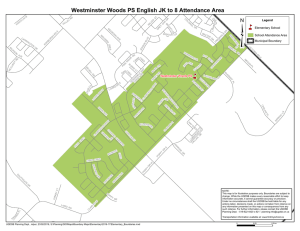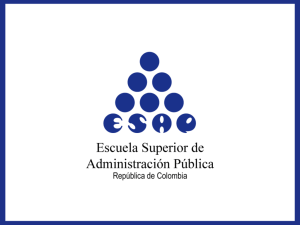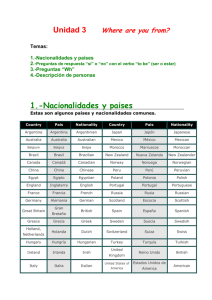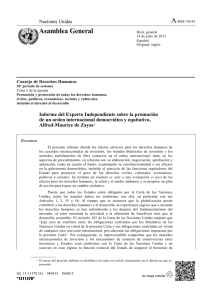Chile
advertisement
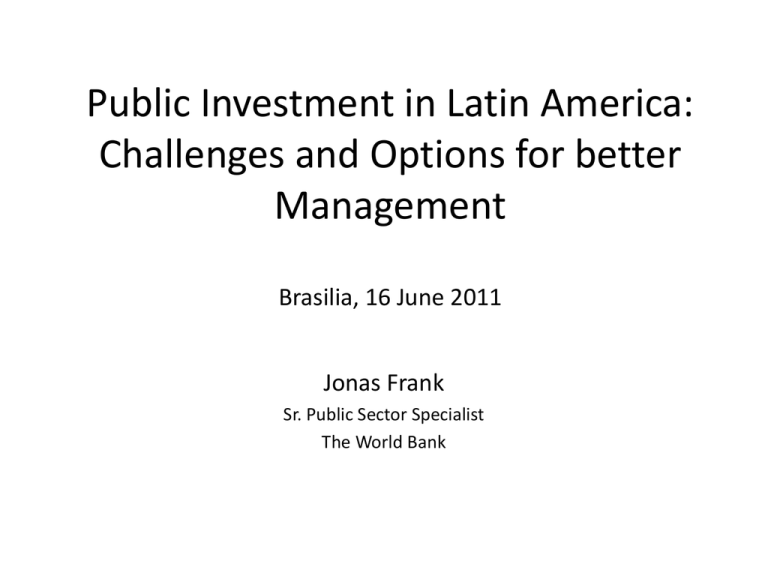
Public Investment in Latin America: Challenges and Options for better Management Brasilia, 16 June 2011 Jonas Frank Sr. Public Sector Specialist The World Bank Main messages • Latin American countries have ample opportunities to improve public investment • It is critical to balance efforts: improved appraisal, implementation monitoring and expost evaluation • It is key to being up-front about political economy factors Latin American countries invest below the world average… … but much less compared to fast-growing economies like China and India There is significant variation across countries in the level of investment spending… GDP Source: CEPAL (2011) 5 … and overall the quality of services is often still below the world average 200% 150% 100% 50% 0% Source: World Development Indicators World Average Average Provision of Services in LAC, 1989-2010 (World Average = 100) Public investment management has evolved over time… Phases 1960s 1970s 1980s-1990s 2000s Economic and Fiscal Context • • Vicious circle Structures • • Oil crisis Debt push • • • Adjustment External shocks Washington consensus • Growth Public Management Models and Public Investment • • • • Public • Investment Plan • (4-6 years, donor driven) • Planning Projects Exante control Project Bank Situational planning Exante control • • • • SNIP: Public Investment Systems Strategic planning Integrated financial management Single Treasury Account • • • • • Multi-year planning Results-based management Monitoring and Evaluation Web-based modules E-Government … and led to different institutional arrangements • Ministries of Finance (managing all cycle) • Peru, Argentina, El Salvador, Honduras, Panama, Mexico • Planning entities • Colombia, Bolivia, Ecuador, Brazil, Costa Rica, Venezuela • Role of Presidencies: Nicaragua, Guatemala • Variations: • Role of sector entities • Subnational governments Ex Ante Evaluation Planning Entity Ex Post Evaluation Budget Formulation Budget Execution Finance Ministry “SNIPs” (Public Investment Systems) have been created but often stand in isolation… • Capture information for the whole project cycle • Information for investment budget • Supports monitoring • Project culture • But often SNIP remained an isolated system: • Financial management • Procurement … and the coverage of SNIPs is still uneven… • Colombia • 100% of central government investment • Less for subnationals (no full data) • Dominican Republic: • 90% of central government investment; • Subnationals part of the system only as of 2009 • Peru: • Central level: 80% (2009) • Regions: 97% • Municipalities: 76% • Mexico: • 76% of federal investments (2009) • Guatemala: • 48% of central government … and so is the integration with Financial Management Systems Country Brazil Colombia Chile Costa Rica Guatemala Honduras Paraguay Interface IFMIS vs SNIP yes yes yes no no yes no Perú Bolivia Uruguay Source: IDB Survey 2009-2010 and World Bank no no no Single project code in IFMIS yes yes yes no no yes (social investments) yes (in execution stage but not at pre-investment level) yes yes yes Case of Bolivia: system overlaps and gaps Nivel de Gobierno CICLO DE LA INVERSIÓN PÚBLICA Sistema de Info. Formulación Presupuestación Ejecución Seguimiento SISIN web SIGMA Central SPI -MOP Aplicativo MMyA SAP - FPS/FNDR Aplicativo - VT SISIN web Departamental SIGMA SGP SIGMA local SISIN web (GM) Municipal SIGMA (GM) SGP SIGMA local Source: World Bank CMC Evaluación Incentive problems • Under-estimation of costs, overestimation of benefits • Cumbersome processes – Because of administrative bottle-necks in SNIPs – Because of improved evaluation • Peru: refinement of appraisal methodologies • Nicaragua: 26 appraisal methodologies • Consequences: – Weak gate-keeping – Unproductive investments Decentralization without planning and coordination can lead to fragmentation of projects… Gobierno Nacional Example of Peru Gobiernos Regionales Gobiernos Locales 19,798 18,891 3,190 2,837 3,072 13,299 7,186 1,332 1,022 1,505 1,183 2,035 2,816 2,142 1,885 2,319 2,321 2,409 2004 2005 2006 2007 2008 2009 Fuente: SNIP …and sometimes strong subnational autonomy can create additional pressures to spend... creating risk of stop-and-go financing and incomplete projects Argentina: bottom-up process and fiscal decisions on project selections Proceso de Elaboración del Plan Nacional de Inversiones Públicas Dirección Nacional de Inversión Pública Organismos Presupuestarios Oficina Nacional de Presupuesto Relevamiento de la Demanda de Inversiones Criterios de priorización Abril Relevamiento de la Demanda de Inversiones Abril Mayo Priorización de los proyectos Julio Definición de Techos Mayo Consultas a Provincias Mayo Presupuestarios Selección Definitiva de Proyectos Plan Nacional de Inversiones Públicas Provincias Remisión de documentación Octubre Agosto Presupuesto de Inversiones Plan Nacional de Inversiones Públicas Septiembre Octubre Dictamen Source: Ministry of Economy, Argentina Recent growth episode has led to resource abundance and challenged execution rates… El Salvador: Planned and executed public investment, 2006-2010 (in million US$) 2.5% PIB 2.6% PIB 2.5% PIB 2.3% PIB 2.9% PIB 16,000 Millones Millones Peru case 14,000 14,000 12,000 12,000 10,000 10,000 8,000 8,000 6,000 6,000 4,000 4,000 2,000 2,000 0 0 2005 Source: Dirección General de Inversión y Crédito Público, Ministerio de Hacienda, El Salvador 16,000 2006 2007 2008 2009 Governments PIMLocal Gobiernos Locales Ejecutado Source: SNIP, Peru Blue: planned budgets Red: executed budgets 2005 2006 2007 2008 2009 Regional Governments PIM Gobiernos Regionales Ejecutado … while expenditures are often still inequitable Case of Guatemala 800.00 Relación Inversión Pública 2011 vrs. Porcentaje de Pobreza Nacional por Departamento 90.00% 80.00% 700.00 70.00% 600.00 60.00% 500.00 50.00% 400.00 40.00% 300.00 30.00% 200.00 20.00% 100.00 10.00% Departamentos Multiregional Guatemala San Marcos El Progreso Quiché Petén Huehuetenango Sololá Quetzaltenango Chimaltenango Chiquimula Izabal Jutiapa Suchitepéquez Zacapa Sacatepéquez Jalapa Santa Rosa Totonicapán FONPETROL 0.00% Retalhuleu - Baja Verapaz Millones de Quetzales Porcentaje Pobreza Total Inversión en el Departamento Incentive problems can be overcome if political pressures are channeled and used adequately… Electoral campaigns promise more infrastructure works … and attention is also paid to improving implementation and ex-post evaluation A balancing act 19 It is critical to create incentives for cooperation and information exchange • System integration – Procurement module critical • Platforms for coordinated subnational planning and budgeting – Chile: “Convenios de Programación” (but deconcentrated regional level) – OECD countries • France: Contrats de Plan Etat-Région • Germany: joint tasks • Spain: agreements (“convenios”) • Coordination within central government: – Mexico: “Infrastructure Cabinet” led by Presidency • Emerging discussion: defining and benchmarking standards of capacity Chile is putting SIGFE at the core… Source: Proyecto SIGFE (Sistema de información para la gestión financiera del estado) Gobierno de Chile. …and in Colombia systems cover all steps of the investment cycle Formulation BPIN SIGOB Budget Evaluation Programming Monitoring SPI Execution SIIF Source: SUIFP - DNP Other countries are trying other solutions: • Interfaces: Honduras (SIAFI/SIGADE/SISPU/DEI/BANCO CENTRAL) • System Integration: Costa Rica (ERP) • Reducing parallelism: Discussions in Bolivia (SISIN-SIGMA) Current efforts at improving ex-ante controls • Independent evaluations in only a few countries – Argentina (starting) – Mexico: energy, water, and transport • Chile: simplifying evaluation methodologies – Focus on value added and time reduction – Policy: • “social and economic evaluation should not hold up efficient projects” • Maximize Net Present Value – – – – Multi-sector benefits Risk analysis, interdependence, externalities Base line for ex post evaluation Expert group for technical advice Chile: risk approach (example airports), demand analysis, and possibilities to delay financing Nicaragua: Procurement Module is critical for monitoring physical and financial execution • Monitors execution in two moments: at the award stage and during execution of contracts Sistema de Preinversión • Execution is monitored based on contract programming and milestones Banco de Proyectos Sistema de Seguimiento Source: SNIP Nicaragua Sistema de Programación El Salvador: improved monitoring with a results-focus PRESIDENCIA MINISTRA/ O CIUDADANIA Semanalmente atiende Alertas, Restricciones y Oportunidades Mensualmente Toma conocimiento del Avance , Indicadores e indica reprogramaciones GERENTE DE META Registro semanal Restricciones, Alertas y Oportunidades COORDINADOR INSTITUCIONAL Semanalmente atiende Alertas - Restricciones y valida oportunidades Registro Mensual: Logros del último mes e Indicadores Mensualmente valida Reporte de Avance e Indicadores GRUPO DE ESTRATEGIA Semanalmente atiende Alertas, Restricciones y Oportunidades Transectoriales Mensualmente Toma conocimiento del Avance , Identifica sinergias y toma decisiones PRESIDENTE Recibe propuestas de acción presidencial: normativas, técnico-administrativas, político directas y de acción comunicacional Source: SNIP El Salvador Interactive system in Chile… Source: MIDEPLAN, Chile … with geo-referencing Gobierno de Chile | Ministerio de Planificación 29 Source: MIDEPLAN, Chile Efforts at ex-post monitoring are limited • Chile: Reporting on programs to Congress; baselines • Peru: creating and refining methodologies (four levels of results and impacts) • Creating more demand is critical – Users of services – Within the administration It is critical to being strategic about the way forward ”Pareto-Strategy” in Mexico: focus on high expenditure areas 400 Hidrocarburos ($228/537) 360 About 90% of investment is concentrated in three sectors: hidrocarbon, communications/trans port and electricity 320 Monto Asignado en 2009 (376 mil millones de pesos) 280 61% 240 200 Medio Ambiente ($11/176) 160 15% SCT Salud ($64/1,683) ($10/175) Impartición de Justicia 120 17% ($7/52) Electricidad Fomento ($40/450) ($6/146) 46% 80 Educación 11% ($5/190) 12% 40 Distribución de la cartera total por sector (monto y tipo de proyectos) Seguridad Nacional ($4/76) Ejecutivo Federal ($3/161) 0 1,000 2,000 3,000 4,000 Número de Proyectos (3,652 proyectos) Fuente: Subsecretaría de Egresos de la SHCP/ Tomo VII PEF 2009 / Análisis Deloitte 31 A Network of LAC Directors of Public Investment was founded in October 2010 in Panama • Annual meetings, exchange of information, consultations • Support from CEPAL, IADB, and World Bank 32
